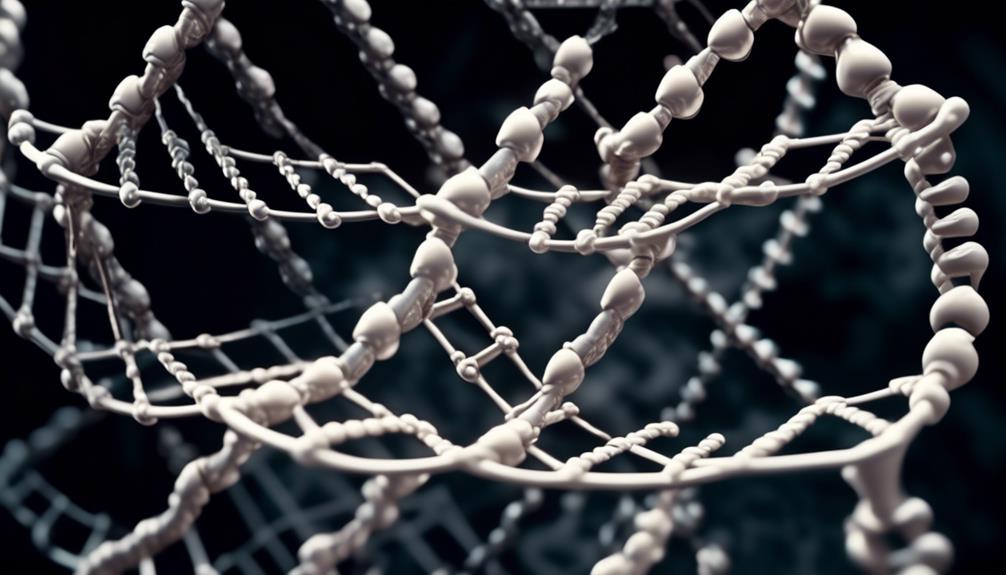DNA Structure Discovery (1953) – Watson & Crick: Recap and Summary: Unveiled DNA's Shape

James Watson and Francis Crick revolutionized genetics in 1953 by unveiling the structure of DNA. This groundbreaking discovery unraveled the enigma of how genetic information is stored and transmitted. Their revelation of DNA's shape forever changed our understanding of the secret of life itself.
Key Takeaways
- Scientists worldwide are actively pursuing breakthroughs and competing to uncover DNA's intricacies.
- The double helix model revolutionized our understanding of DNA's structure.
- X-ray crystallography is a powerful technique to determine molecular structures.
- Understanding helix stability is crucial for DNA replication and gene expression.
The Race for Understanding
In the race for understanding DNA's shape, scientists around the world are actively pursuing breakthroughs and competing to uncover its intricacies. It's a race against time as they strive to unlock the mysteries of this fundamental building block of life. The scientific community is constantly pushing the boundaries of knowledge, fueling a relentless pursuit for new discoveries.
With each passing day, new scientific breakthroughs shed light on the structure and function of DNA. Researchers are using advanced techniques and cutting-edge technologies to delve deeper into this complex molecule. They're driven by the desire to unravel its secrets and harness its potential for medical advancements, genetic engineering, and forensic analysis.
This global race for understanding DNA's shape has led to remarkable progress. Scientists have made significant strides in deciphering the double helix structure of DNA, thanks to the groundbreaking work of James Watson and Francis Crick in 1953. Their discovery laid the foundation for countless scientific endeavors and paved the way for future breakthroughs.
However, the journey is far from over. Scientists continue to explore the intricacies of DNA, uncovering its role in disease development, evolution, and inheritance. The race for understanding DNA's shape is an ongoing endeavor, fueled by the endless quest for knowledge and the desire to unlock the secrets of life itself.
Building Blocks of Life
Scientists are now exploring the fundamental building blocks of life, as they continue their quest to understand DNA's shape and unravel its secrets. The discussion around the building blocks of life revolves around two key ideas: the origin of life and its evolutionary significance.
The origin of life is a topic of great interest and speculation. Scientists have proposed various theories to explain how life may have emerged on Earth. One popular hypothesis is that life originated from simple organic molecules, such as amino acids, which eventually formed more complex molecules like proteins. These complex molecules then came together to form the first living organisms.
Understanding the building blocks of life also has significant evolutionary significance. By studying the molecular structures of DNA, RNA, and proteins, scientists can trace the evolutionary relationships between different species. They can analyze the similarities and differences in genetic material to understand how organisms have evolved over time and adapted to their environments.
The study of the building blocks of life is crucial for unlocking the secrets of DNA's shape and function. By delving into the origin of life and its evolutionary significance, scientists hope to gain a deeper understanding of the complexity and diversity of life on our planet. This knowledge could potentially have far-reaching implications, not just in the fields of biology and genetics, but also in medicine, agriculture, and environmental sciences.
The Double Helix Model
Examine the groundbreaking discovery of the double helix model, which revolutionized our understanding of DNA's structure. The double helix model, proposed by James Watson and Francis Crick in 1953, revealed the elegant structure of DNA as a twisted ladder. This model provided a clear explanation for how DNA replicates and carries the genetic code.
The double helix consists of two strands of DNA that are twisted around each other in a spiral shape. The strands are made up of nucleotides, which are the building blocks of DNA. Each nucleotide consists of a sugar, a phosphate group, and a nitrogenous base. The nitrogenous bases, adenine (A), thymine (T), cytosine (C), and guanine (G), pair up in a specific way: A always pairs with T, and C always pairs with G. This pairing is known as complementary base pairing.
The double helix model also provided insights into how DNA replicates. During replication, the two strands of DNA separate, and each strand serves as a template for the synthesis of a new complementary strand. This process ensures that each new DNA molecule contains an exact copy of the original genetic code.
The discovery of the double helix model was a pivotal moment in the field of genetics. It provided a structural basis for understanding how DNA carries and replicates the genetic information that determines the characteristics of all living organisms. This groundbreaking discovery laid the foundation for further research and advancements in the field of molecular biology.
X-Ray Crystallography
Now let's delve into the world of X-Ray Crystallography, a powerful technique used to determine the crystal structure of molecules.
With this method, scientists are able to confirm the helical structure of DNA and gain insights into its molecular arrangement.
Crystal Structure Analysis
Using X-ray crystallography, researchers can determine the crystal structure of DNA. This technique played a crucial role in the discovery of DNA's double helix structure. Here's why crystal structure analysis is important in DNA structure determination:
- X-ray diffraction: X-rays are passed through a crystal of DNA, resulting in a diffraction pattern that can be used to determine the positions of atoms within the crystal.
- Accurate measurements: X-ray crystallography provides precise information about the distances and angles between atoms in a molecule, allowing for a detailed understanding of DNA's three-dimensional structure.
- Structural insights: By revealing the arrangement of the sugar-phosphate backbone and the base pairs, crystal structure analysis helps scientists understand how DNA stores and transmits genetic information.
X-ray crystallography enables us to unlock the secrets of DNA's structure, providing us with a deeper understanding of life's fundamental building blocks.
DNA Helix Confirmation
Researchers can confirm the helical structure of DNA through X-ray crystallography, providing valuable insights into its three-dimensional arrangement. By subjecting DNA crystals to X-ray beams, researchers can analyze the resulting diffraction pattern and determine the positions of atoms within the molecule. This technique has revealed the stable double helix structure of DNA, with the two strands spiraling around each other and held together by hydrogen bonds. Understanding the stability of the DNA helix is crucial, as any disruption to its structure can have profound effects on DNA replication, gene expression, and overall cellular function. By elucidating the DNA replication mechanism and ensuring the integrity of the helical structure, X-ray crystallography plays a vital role in our understanding of genetics and the fundamental processes of life.
| DNA Helix Stability | DNA Replication Mechanism |
|---|---|
| Helical structure of DNA provides stability and protection to the genetic material | DNA replication is a highly precise and regulated process |
| Disruption of the DNA helix can lead to genetic mutations and diseases | DNA polymerase enzymes ensure accurate replication of DNA |
| Maintaining the stability of the DNA helix is essential for cellular function | DNA replication occurs in a semi-conservative manner |
| Environmental factors and DNA-binding proteins can influence helix stability | Multiple proteins and enzymes are involved in DNA replication |
| Understanding helix stability can lead to advancements in medicine and genetic engineering | Errors in DNA replication can result in genetic disorders and cancer |
Molecular Arrangement Determination
To determine the molecular arrangement of DNA, X-ray crystallography is a powerful technique used by scientists. This method allows for the analysis of the structure of molecules by examining the diffraction patterns produced when X-rays pass through a crystal. In the field of structural biology, advancements in X-ray crystallography have revolutionized our understanding of DNA and other biological molecules.
Here are two key benefits of using X-ray crystallography for molecular arrangement analysis:
- High-resolution imaging: X-ray crystallography provides detailed information about the atomic positions within a molecule, allowing scientists to accurately determine its structure.
- Insight into biological processes: By analyzing the molecular arrangements of DNA and other biomolecules, researchers can gain insights into their functions and interactions, leading to advancements in fields such as drug discovery and genetics.
Complementary Base Pairing
Now let's talk about complementary base pairing in DNA. It's the mechanism through which DNA strands are held together by hydrogen bonds between specific nucleotide base pairs.
The base pairing rules in DNA dictate that adenine (A) always pairs with thymine (T), and guanine (G) always pairs with cytosine (C).
This precise pairing allows DNA to replicate accurately and maintain its genetic information.
Base Pairing Mechanism
The base pairing mechanism in DNA, known as complementary base pairing, plays a crucial role in determining the shape and function of the molecule. Through this mechanism, the nitrogenous bases adenine (A) pairs with thymine (T), and guanine (G) pairs with cytosine (C). This pairing is essential for DNA replication, a process in which the double-stranded DNA molecule is copied to create two identical DNA molecules.
During replication, each strand of the original DNA molecule serves as a template for the synthesis of a new, complementary strand. The base pairing mechanism ensures that the new DNA molecule is an exact replica of the original, maintaining the genetic information. Without this mechanism, accurate replication and transmission of genetic material wouldn't be possible.
DNA Base Complementarity
DNA base complementarity, also known as complementary base pairing, is a fundamental principle in genetics that governs the precise pairing of nucleotides within the DNA molecule.
Complementary base pairing refers to the specific pairing between the nitrogenous bases of DNA, where adenine (A) always pairs with thymine (T), and guanine (G) always pairs with cytosine (C). This pairing is essential for DNA replication and transcription, as it ensures the accurate transmission of genetic information.
The complementary base pairing also has significant genetic implications. It allows for the formation of double-stranded DNA, which provides stability to the molecule and allows for efficient DNA replication and repair.
Additionally, complementary base pairing is crucial for the process of DNA sequencing, which allows scientists to determine the order of nucleotides in a DNA molecule, leading to a better understanding of genetic variation and disease.
Pairing Rules in DNA
To understand the rules of DNA pairing, it's essential to grasp the concept of complementary base pairing. The base pairing mechanism in DNA follows specific rules that ensure the accurate replication and transmission of genetic information. Here are the pairing rules:
- Adenine (A) always pairs with Thymine (T)
- Guanine (G) always pairs with Cytosine (C)
These pairing rules are due to the chemical structure of the bases. Adenine and Thymine form two hydrogen bonds, while Guanine and Cytosine form three hydrogen bonds, allowing for stable base pairing.
This complementary base pairing is crucial for DNA replication, as the two strands of the DNA molecule can separate and serve as templates for the synthesis of new DNA strands. By following the pairing rules, the DNA molecule can maintain its genetic code and pass it on accurately to future generations.
Unraveling DNA's Structure
Scientists have made significant strides in understanding the structure of DNA. Through years of research and experimentation, they've unraveled the genetic code and uncovered the intricate mechanism behind DNA replication.
The unraveling of the genetic code was a groundbreaking discovery in the field of genetics. Scientists discovered that DNA is composed of four nucleotide bases – adenine, thymine, cytosine, and guanine – which form a double helix structure. These bases pair together in a specific manner, with adenine always pairing with thymine, and cytosine always pairing with guanine. This pairing allows for the accurate transmission of genetic information during DNA replication and protein synthesis.
Understanding the DNA replication mechanism was another significant milestone. Scientists discovered that DNA replication occurs through a semi-conservative process, where the two strands of the DNA molecule separate and each strand serves as a template for the synthesis of a new complementary strand. This process ensures that each new DNA molecule contains one original strand and one newly synthesized strand, preserving the genetic information.
Implications for Genetics
After unraveling the structure of DNA and understanding its replication mechanism, the discoveries made in genetics have far-reaching implications. These implications are particularly significant in the field of genetic disorders, as the identification of DNA's structure has provided scientists with a better understanding of the genetic basis of these conditions.
Here are two key implications of DNA structure discovery in the context of genetics:
- Diagnosis and Treatment: The knowledge of DNA's structure has enabled scientists to identify specific genetic mutations that are associated with various genetic disorders. This has revolutionized the field of genetic diagnostics, allowing for more accurate and efficient testing methods. Additionally, the understanding of DNA's structure has paved the way for the development of gene therapy, a promising approach that aims to treat genetic disorders by introducing correct copies of genes into affected cells.
- Preventive Measures: The discovery of DNA's structure has also opened up new possibilities for preventive measures in the field of genetics. By identifying the genetic mutations that contribute to the development of certain disorders, scientists can now develop strategies to prevent these mutations from occurring or mitigate their effects. This knowledge has the potential to revolutionize healthcare, allowing for personalized preventive interventions based on an individual's genetic profile.
Legacy and Future Discoveries
The legacy of unraveling DNA's structure continues to shape the future of scientific discoveries. The impact of Watson and Crick's groundbreaking work on DNA has been profound, paving the way for numerous advancements and opening up new avenues of research. Their discovery of DNA's double helix structure revolutionized the field of genetics and laid the foundation for our understanding of heredity and the role of DNA in life.
The legacy of their work can be seen in the numerous advancements that have followed. The ability to sequence and manipulate DNA has led to breakthroughs in fields such as medicine, agriculture, and forensic science. DNA sequencing has become faster, more accurate, and more affordable, allowing researchers to study genetic diseases, develop personalized treatments, and even modify the genetic makeup of organisms.
Looking towards the future, the impact of unraveling DNA's structure is only expected to grow. Advancements in gene editing technologies like CRISPR-Cas9 hold the potential to cure genetic diseases, create disease-resistant crops, and even enhance human capabilities. The understanding of DNA's structure has also paved the way for synthetic biology, where scientists can engineer new organisms with desired traits.
Frequently Asked Questions
What Were Some of the Other Significant Discoveries in the Field of Genetics Around the Same Time as the DNA Structure Discovery?
Around the time of the DNA structure discovery, other significant discoveries in genetics included the identification of genetic mutations and the understanding of DNA replication. These findings expanded our knowledge of how DNA functions and evolves.
How Did the Discovery of Dna's Structure Impact the Field of Medicine?
The discovery of DNA's structure revolutionized medicine. Its impact on healthcare is immense, with potential applications in genetic testing, personalized medicine, and the development of targeted therapies. The future holds limitless possibilities.
What Were the Main Challenges Faced by Watson and Crick During Their Research?
Discovering the structure of DNA was no easy task for Watson and Crick. They faced numerous challenges in their research, but their breakthrough had a profound impact on medicine, revolutionizing our understanding of genetics.
How Did the Scientific Community React to the Publication of Watson and Crick's Paper on Dna's Structure?
The scientific community reacted with astonishment and excitement to Watson and Crick's paper on DNA's structure. Their discovery revolutionized biology and had a profound impact on medicine, leading to advancements in genetics and personalized treatments.
What Are Some of the Ongoing Research and Future Discoveries in the Field of DNA Structure and Genetics?
You'll be thrilled to know that ongoing research in genetics is pushing boundaries and uncovering amazing things. Future discoveries in DNA structure are on the horizon, bringing us closer to understanding the intricacies of life itself.









